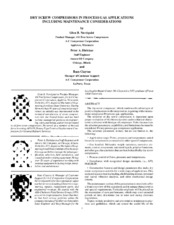| dc.description.abstract | The dry screw compressor, which combines the advantages of positive displacement with rotary motion, is gaining wider international acceptance for process gas applications. The selection of dry screw compressors is dependent upon proper evaluation of the thermodynamic and mechanical characteristics inherent with this type of compressor. To be discussed are the selection parameters, capabilities, and limitations that must be considered for any process gas compressor application. The selection parameters include, but are not limited to, the following: • Application range: Flows, pressures and temperatures suited for screw compressors as compared to other types of compressors. • Gas handled: Molecular weight variations, corrosive elements, erosive components, entrained liquids, polymer formation, and other gas characteristics that can best be handled by dry screw compressors. • Process control of flows, pressures and temperatures. • Compliance with recognized design standards, i.e., API, PNEUROP. • Construction features and design parameters that make dry screw compressors suitable for a wide range of applications. This section discusses bearing loading, shaft bending stresses, torsional and lateral vibration analysis, and other mechanical design criteria. The maintenance section of this presentation is intended to offer a broad overview of this equipment and its unique characteristics and special requirements. Particular emphasis will be placed on the restoration of aero performance, which may over extended periods of time deteriorate due to rotor and casing clearance degradation. Topics include predictive and preventative maintenance practices and guidelines, which can extend the useful life of the equipment and minimize unexpected outages, field overhaul techniques, repair shop procedures and rotor and case repairs including welding, coatings, seal stripping, and metal locking. | en |


